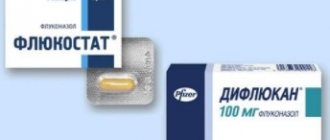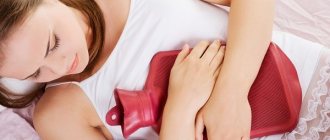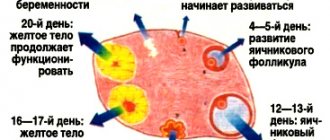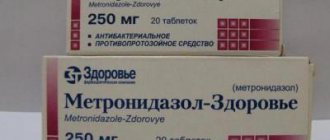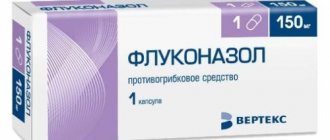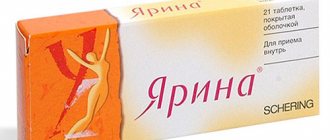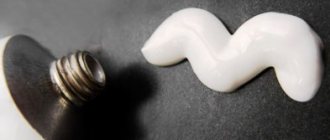More than half of all representatives of the fair sex have encountered the problem of vaginal candidiasis or thrush at least once in their lives. Often such a pathology occurs on menstrual periods, and many patients use flucostat during menstruation to treat this disease. According to reviews from clients of the antenatal clinic, candidiasis causes a lot of painful sensations, and monthly bleeding always leads to increased pain and discomfort. To choose the appropriate therapy, you need to understand the connection between thrush and menstruation.
Why does Flucostat help against thrush during menstruation?
Thrush is a fungal disease; changes in vaginal flora during the menstrual cycle create favorable conditions for the development of this fungus.
Manufacturers used the substance fluconazole as the basis for the manufacture of this medicine. This component is also found in other medications. This happens due to the fact that this substance acts directly on fungi such as Candida and several other types of bacterial formations. In addition to this component, the composition is enriched with a large number of additional substances. This is the main difference between a medicine and drugs with a similar focus. A properly selected composition allows the use of flucostat to combat a wide range of pathogens.
Flucostat is available in the form of capsules for oral administration. The capsules quickly dissolve in the stomach, and the active ingredients are absorbed into the walls of the stomach and intestines within a short time. The medicine practically does not dissolve in the blood and reaches the required area in the maximum possible volume.
It has been proven that the therapeutic activity of the drug is the highest compared to close substitutes. If you take the medicine, the maximum effect is achieved within 48 hours; the first signs of improvement appear already at the end of the first day after taking it.
You can take flucostat without fear; it causes virtually no side effects.
Recommended analogues
There are a lot of fluconazole derivatives, more than 30. These include Diflucan, Flucoside, and Diflazon. They are available in different forms (capsules, suppositories, injection solutions) and contain different amounts of active ingredient. The doctor can select other antifungal drugs, but only after finding out what caused the thrush and what is the sensitivity of the fungi to a particular drug.
You cannot decide on your own which remedy to take; you can achieve stable resistance of the fungi and “get” chronic thrush.
How to take Flucostat correctly during menstruation
When taking Flucostat, you just need to strictly follow the instructions and the effect of the medicine you drink will come fairly quickly.
Unlike other medications, the intake does not need to be supplemented with vaginal suppositories, which is simply impossible during menstruation. It is enough to drink one capsule to feel relief. But for a complete cure, it is recommended to take the full course. The ability to take only tablets without additional therapy is a distinctive feature of Flucostat. The medicine affects only fungal formations, without affecting the vaginal flora as a whole.
You can start taking the medicine on the first day of your period. Most often, this is the approach that is recommended. Since on this day the exacerbation of thrush begins, and the medicine can be most effective.
Taking the medicine is not affected in any way by the time of meal or time of day; you can take the capsule immediately after detecting such a need.
It is worth understanding that the flucostat does not affect the course of menstruation. The drug is not a hormonal type drug. The only thing a woman may notice while taking the capsules, a slight increase in blood discharge, is due to the fact that they lower the level of potassium in the blood, but this effect is temporary and not very pronounced.
Taking the medicine can be combined with pills that alleviate a woman’s condition during her critical days. These medications do not conflict with each other and do not affect each other’s effectiveness.
Flucostat treatment regimens
Depending on the severity of the condition, three medication dosage regimens are possible:
- Take only one 150 mg capsule. Suitable for mild, uncomplicated disease. The symptoms are mild and do not cause severe discomfort.
- Take one 150 mg capsule every 72 hours. 1 tablet is taken on the first day, the second on the 4th day. The symptoms in this case are much more pronounced: unbearable itching, burning or swelling of the labia.
- Capsules are taken three times: on the first day, on the 4th and on the 7th day. This regimen is recommended for progressive thrush with relapses (if exacerbation occurs more than 4 times a year). Your doctor may prescribe an additional course lasting up to 6 months; in this case, it is recommended to take 1 capsule per week.
The medicine is designed to be taken during menstruation. Despite its safety, it would be a good idea to consult a gynecologist about drug therapy. Only he will be able to voice an accurate diagnosis and prescribe the necessary treatment.
source
The principle of action of the drug
Changing the vaginal microflora creates a favorable environment for the development of bacteria . The proliferation of candida during menstruation is facilitated by the release of the hormones progesterone and estrogen. Bloody discharge turns the environment in the vagina acidic, which also provokes the proliferation of fungus.
Many experts answer the question in the affirmative whether Flucostat can be taken during menstruation. The main component of this medicine is Fluconazole. This substance acts on fungi such as candida and several other types of bacterial infections. It is the wide spectrum of action of the drug that distinguishes it from other antifungal agents.
Available in capsule form. They quickly dissolve and are absorbed into the walls of the stomach and intestines. Its therapeutic activity is very high, since the drug is practically insoluble in the blood . The therapeutic effect occurs after approximately 48 hours, but the first improvements can be noticed on the first day. You can take it without fear, because it has no side effects.
Pharmacological properties of Flucostat
The antifungal effect of the drug is provided by fluconazole, which is part of the drug. Actually, Flucostat is just that, it’s just produced under a different trade name. The active substance (fluconazole) selectively inhibits the synthesis of sterols in the cells of Candida fungi. To put it simply, to reproduce, fungi need to synthesize organic compounds (sterols) and “build” cell membranes from them. No sterol - no membrane - no new yeast cell. The progression of the disease has been stopped. The medicine is practically insoluble, which allows it to be “delivered” unchanged to the site of the disease.
The logic of this process provides the answer to the question: is it possible to take Flucostat tablets during menstruation. Yes, you can, for the following reasons:
- the drug is absorbed in the intestines and penetrates all fluids and tissues of the body (including the blood and the vaginal mucosa);
- the maximum concentration in blood plasma is observed after 0.5–1.5 hours and does not depend on hormonal levels or blood loss;
- taking antispasmodics does not affect the effectiveness of the medicine.
Pattern of medication use
The doctor can prescribe Flucostat at any stage of thrush development. The treatment regimen will depend on the severity of the woman’s condition:
- For mild candidiasis, 1 capsule per day is enough, dosage 150 mg.
- If severe symptoms appear in the form of severe burning and itching, as well as swelling of the labia, then the drug is prescribed 1 capsule of 150 mg on the first and fourth days of menstruation.
- For progressive thrush, the medicine is taken three times: on days 1, 4 and 7.
Flucostat is specially designed so that it can be taken during menstruation. Although this is a completely safe remedy, it is better to consult a doctor before starting to take it.
Possible side effects
Of all fluconazole-based drugs, Flucostat has the fewest side effects. But, like any medical drug, they are still possible.
The most common symptom is indigestion. Sometimes nausea and headache may occur, and very rarely, convulsions. Menstruation may take a little longer than usual, since due to a decrease in potassium in a woman’s body, the water-electrolyte balance may be disrupted. The occurrence of any side effects of the drug is an extremely rare occurrence, but still it should not be ruled out at all.
The drug is not addictive, and therefore an overdose is extremely rare. Even if a woman takes a double dose, activated charcoal will easily solve this problem.
Many girls are concerned about whether Flucostat can cause a delay in menstruation. There are cases when thrush causes changes in the menstrual cycle, but this has nothing to do with taking Flucostat. Most often these changes occur due to:
- A sharp change in the content of sex hormones in the blood, which causes the development of fungi. This condition is typical for women of premenopausal age. Then thrush is secondary, namely, hormone imbalance is the main cause of cycle failure.
- There are often situations when menstruation is completely absent against the background of vaginal candidiasis. This happens during the period of conception, since thrush occurs in most cases during pregnancy. Then it is better to consult a doctor to cope with candidiasis before giving birth.
The question of whether it is possible to take Flucostat during menstruation should only be resolved with your doctor. According to statistics, it is prescribed more often than other antifungal drugs. Thrush is a fairly common problem that can be easily solved by taking this drug.
source
Opinion of gynecologists
Menstruation itself cannot be a contraindication to antifungal therapy. However, doctors recommend, if possible, waiting until the discharge ends and then starting treatment.
This is only due to the fact that after taking it you can evaluate the effect of the medicine at any time: take a smear, conduct an examination.
When to start taking antifungal medications should be decided by a woman together with her doctor. Menstruation cannot be considered one of the main factors influencing decision-making.
How will flucostat help overcome thrush during menstruation?
More than half of all representatives of the fair sex have encountered the problem of vaginal candidiasis or thrush at least once in their lives. Often such a pathology occurs on menstrual periods, and many patients use flucostat during menstruation to treat this disease. According to reviews from clients of the antenatal clinic, candidiasis causes a lot of painful sensations, and monthly bleeding always leads to increased pain and discomfort. To choose the appropriate therapy, you need to understand the connection between thrush and menstruation.
How menstruation provokes the development of vaginal candidiasis
A gynecologist is often asked the question: “Can flucostat be used during menstruation?” Before prescribing treatment, the specialist must explain to the woman the reasons for the deterioration of her condition during this period.
It should be immediately noted that the occurrence of thrush is not associated with the onset of menstruation in women, however, monthly bleeding can be the reason why candidiasis progresses. For this, there are a number of provoking mechanisms for the development of the disease.
In second place, experts put changes in vaginal acidity during menstrual bleeding. The acidic environment caused by bloody discharge leads to the development of thrush.
We should not forget about hygienic problems during this period. Quite often, a young woman does not pay attention to the chemical composition of pads and other hygiene products, which, with a weakened immune system, can also provoke the rapid growth of fungi in the vagina.
When asked by patients whether flucostat can be used during menstruation, the main group of specialists answers in the affirmative. This is due to the mechanism of action of this drug, its physiological activity and minimal side effects.
What is flucostat: the main parameters of the drug substance
Modern medicine uses a large number of drugs for the treatment of vaginal candidiasis, based on fluconazole. One such medicine is flucostat.
This antifungal agent mainly affects fungi of the Candida family, as well as some strains of bacteria. It is the wide spectrum of action that distinguishes this drug from its analogues.
Flucostat is available for administration in capsule form, as it is well absorbed in the patient’s stomach and intestines. Considering that this medicine is practically insoluble in the blood and completely reaches the required place, its therapeutic activity is the highest among all fluconazole derivatives.
The drug reaches its maximum medicinal peak 48 hours after administration, however, the first positive symptoms from treatment can be noticed by the end of the first day.
Features of the drug
Flucostat is a modern antifungal drug that is available in tablet form (capsules), as a solution and as vaginal suppositories. The main active substance is fluconazole, an effective chemical compound that is added to many drugs designed to combat diseases caused by yeast and yeast-like fungi.
Flucostat is an antifungal drug
Fluconazole is absorbed into the bloodstream, quickly reaching the site of infection and gradually increasing its concentration. Due to the fact that it is able to accumulate in tissues and mucous membranes, the therapeutic effect lasts as long as possible.
The action of Flucostat is similar to most antimycotic and antibacterial agents. The active substance disrupts the synthesis of important substances by parasite cells, as a result of which their cell membrane is destroyed. The drug penetrates the cell and causes its death. The product has a pronounced fungicidal effect, that is, it does not inhibit the development of the pathogen, but provokes its death.
According to the list of the World Health Organization, Flucostat is considered a drug for the treatment of urogenital candidiasis in men and women, including its most common form - vaginal. However, the range of applications of this drug is much wider. In addition to genital thrush, it can be used to treat a number of conditions:
- generalized candidiasis - the fungus affects several organs or even systems, mucous membranes, urinary tract, even eyes;
- fungal infection of the mucous membranes - mouth, esophagus, bronchi, lungs, etc.;
- mycosis of the skin, spreading to the feet, hands, and nails. The drug is also effective against pityriasis versicolor;
- cryptococcosis of the skin, nose, lungs. The drug is relevant for patients with normal and reduced immunity. The drug can be prescribed to patients with cancer or HIV infection;
- mycosis of internal organs is a serious pathology that threatens serious complications.
An important advantage of this drug is that it does not have a detrimental effect on the native microflora of the body, but only on the pathogen.
Features of using this drug during menstruation
Flucostat is considered one of the most necessary modern medicinal substances for the treatment of thrush. First of all, the effect of the drug begins within a few hours after administration. The medication maximally prevents the occurrence of burning in the vagina, itching and various discharges.
In this case, one capsule is enough to solve the problem, although many patients prefer to use it in combination with vaginal suppositories, which is not always possible during menstruation.
Monotherapy is a feature of flucostat. In addition, experts note the high selectivity of the action of the drug. In a woman’s body, this drug destroys only pathological fungi, without having virtually any effect on the steel flora of the vagina.
This property of flucostat allows you to treat with this drug during monthly bleeding. Some experts generally recommend starting treatment for thrush with this remedy on the first day of menstruation. They explain such recommendations by the fact that the onset of menstruation stimulates the development of thrush, and in this case the medicinal effect will be more effective.
If the question arises whether flucostat affects menstruation, you should remember the chemical formula of the drug. This product does not contain hormones, which in turn eliminates the impact on a woman’s hormonal levels. The recommended medicine may slightly increase bleeding because it helps reduce potassium in the blood. The clotting time is slightly increased, but this condition cannot cause critical bleeding.
In addition, most of the drugs used by women to stabilize their condition during these critical days do not interfere with flucostat. An exception may be nonspecific anti-inflammatory drugs used to relieve pain during menstruation and blood thinning medications such as Varvarin. In any case, drug therapy for thrush should only be prescribed to a patient by a doctor, which implies conducting a certain examination and the woman receiving appropriate recommendations.
Most often, this problem has two explanations:
- In premenopausal women, there may be a sharp change in the percentage of sex hormones in the blood, which often causes a sharp increase in fungal flora. Irregular menstruation in this case is a consequence of hormonal shifts, and thrush is secondary.
- Quite often situations arise that lead to the absence of menstruation with severe vaginal candidiasis. This is the conception of a child. Pregnancy often causes thrush. In this case, the woman should contact a specialist in order to cope with the problem before giving birth.
We recommend reading the article about fluconazole during menstruation. From it you will learn about the drug and its effectiveness for thrush, the positive and negative aspects of taking the drug, recommendations for women when treating candidiasis with fluconazole.
It is normal to use Flucostat to treat thrush during your period. This medicinal substance is considered the drug of choice in the fight against candidiasis of the female genital area. And all gossip and rumors about this medicinal substance should be resolved by the patient not on forums, but with the attending physician. Thrush is a rather insidious disease, the treatment of which requires patience and punctuality from a woman. Flucostat and similar drugs will help most young women in the fight against this disease.
source
Flucostat: instructions for use for men, reviews, analogues
1171
Women's health is subject to various influences from external factors. A common disease is thrush, which periodically causes inconvenience. Flucostat is an antifungal drug that is active against many microorganisms in thrush. There are several forms of drug release. The pharmaceutical market offers a wide selection of medications from this group.
Indications
"Flucostat" is indicated for use for various types of fungal infections:
- candidiasis of the genital organs;
- intestinal candidiasis;
- oral candidiasis;
- generalized candidiasis;
- onychomycosis;
- pityriasis versicolor;
- mycosis of the skin;
- cryptococcal infections.
The drug is also prescribed as a prophylactic agent during treatment with antibiotics, in a state of immunodeficiency, as well as during chemotherapy or radiation therapy.
Flucostat
Flucostat is a medicine that is widely used to treat fungal infections in men and women that are caused by yeast or yeast-like fungi.
Brief description of the drug Flucostat
Brief description of Flucostat: the drug belongs to the group of triazoles (not an antibiotic), which selectively act on fungal pathogens.
Flucostat highly selectively affects specific substances - cytochromes P-450, which leads to disruption of the synthesis of complex organic substances (sterols), which are the “building material” for cell membranes. Their deficiency increases membrane permeability and disrupts it. The combination of these disorders leads to the death of the fungal cell.
The inhibitory property of Flucostat also affects enzymes in the human body. However, the drug’s affinity for them is tens of times lower and does not have a clinically significant negative effect.
Composition of the drug, manufacturer and release form
Flucostat contains the active ingredient fluconazole (additionally includes corn starch, silicon dioxide, lactose, magnesium stearate, sodium lauryl sulfate, etc.).
Method of use
The calculation of the dose of Flucostat and the duration of therapy itself depends on the established diagnosis:
- Severe generalized mycosis. The drug must be taken at 200 or 400 mg daily. The course is usually quite long - from half a year or longer.
- Vaginal candidiasis. For acute forms, a single dose of one 150 mg capsule is recommended. If we are talking about the chronic form, then the drug is taken in the same dose once a month on the first day of the menstrual cycle for 4-6 months.
- Candidiasis of the oral mucosa. The drug is prescribed for two weeks. The patient takes 1 capsule of 50 mg per day.
- Cutaneous mycosis of various localizations. 50 mg daily for a week. If necessary, the course is continued for up to 2-3 weeks.
- Pityriasis versicolor. The drug is taken 2 capsules of 150 mg at a time. The duration of therapy is 14 days.
- Mycosis of the nail plate. The recommended dose is 150 mg once every seven days. The drug is continued until a healthy nail plate completely replaces the one damaged by the fungus.
- Intestinal candidiasis. The daily dose is 50-100 mg. The minimum course is two weeks.
- Cryptococcal infections. On the first day of therapy, the patient takes 400 mg of the drug, and on subsequent days - 200 mg. The course is one and a half to two months.
- Prevention of fungal diseases. The patient takes the drug daily at 50-400 mg, depending on the situation. The duration of therapy is determined by the doctor.
Read also…. Vaginitis: treatment, symptoms, causes of vaginitis in women
Flucostat capsules are taken orally with a small amount of clean water.
Release form
- Coated capsules are light pink or pink-brown in color, opaque. Inside there is a white or close to white powder. Packaged in 7 pieces in contour cell blisters. Cardboard packaging holds 1 plate.
- Tablets of 50 or 150 mg are white, oval, secured in a contour-cell blister of 1 or 2. A cardboard pack contains only 1 plate with the drug.
- Solution for intravenous administration in the form of a clear, colorless liquid in 50 ml bottles. One bottle of medicine is placed in a cardboard package.
- White oval-shaped vaginal suppositories, which are packaged in blisters made of aluminum foil or PVC.
We suggest you familiarize yourself with Herpes on the skin: how to treat it
special instructions
The drug must be taken with caution if the patient has any impaired renal or liver function. In addition, patients with HIV infection or AIDS require special monitoring, as they have an increased tendency to adverse reactions.
Fluconazole can interact with other drugs: rifampicin, cyclosporine, coumarin anticoagulants, theophylline, etc. For this reason, the use of other drugs is possible only with the permission of a doctor and under his supervision.
Side effects
Despite the popularity of this medication for the treatment of thrush in men, it is not so safe. During death, fungi release a large amount of toxins, which can be associated with a number of reactions.
The main side effects of Flucostat:
- Flatulence
- Stomach ache
- Nausea
- Liver disorders
- Ventricular fibrillation and/or flutter
- Dizziness
- Disorders in the hematopoietic system
- Skin rash
- Convulsions
- Anaphylactoid reactions.
Unfortunately, this medicine is considered very toxic, and taking it can cause a variety of adverse reactions.
First of all, these are nausea, vomiting, pain in the epigastric region, diarrhea, and changes in taste. In addition, weakness and dizziness are possible.
It is also possible that allergic skin reactions may occur, including itching, rash, swelling and redness. In case of overdose, disturbances of consciousness and hallucinations are observed.
Intravenous use of a pharmaceutical drug may cause the following side effects:
- From the gastrointestinal tract: nausea followed by vomiting, flatulence, abdominal pain, functional liver failure (increased levels of alkaline phosphatase, serum aminotransferases or bilirubin).
- Nervous system: headache, seizures.
- From the cardiovascular system: increased duration of the QT interval, ventricular fibrillation or even flutter.
- Allergic reactions: skin rash, Stevens-Jonas syndrome, toxic epidermal necrosis or Lyell's syndrome (an extreme manifestation of toxicoderma), anaphylactic reactions.
- Metabolic processes: hypercholesterolemia, hypokalemia, hypertriglyceridemia.
- From other systems: alopecia, renal failure.
Release forms, composition, price
Available in the form of a parenteral solution and capsules. The main active ingredient is fluconazole.
Parenteral solution
Transparent, odorless, for infusions (injections) in clear glass bottles with holders. Each with a capacity of 50 ml, packed in a cardboard box.
The price of 2 mg/ml 50 ml is about 220 rubles.
Capsules
Opaque, pink in color (interspersed with gray are acceptable) with the contents in the form of a white or yellowish fine powder. Packed in blisters (contour cells) and cardboard boxes.
Price 1 (150 mg) from 175 rub. (manufacturer Masterlek) up to 195 (Pharmstandard-Leksredstva) on average.
Average price 2 pcs. – 340–375.
7 pcs. 50 mg each cost 290–330.
Side effects
As a rule, Flucostat is well tolerated by patients, but it is not without a number of possible side effects:
- From the gastrointestinal tract, abdominal pain, nausea, vomiting, indigestion and taste disturbances may be observed.
- The hepatobiliary region can react with various liver dysfunctions: inflammation, necrosis, increased levels of bilirubin and liver marker enzymes in a blood test.
- Disorders of the central nervous system - pain in the head, disturbance of spatial orientation, involuntary contraction of a muscle or group of muscles, usually accompanied by sharp and aching pain.
- The functioning of the cardiovascular system is disrupted, which is manifested by an increase in the duration of the electrical systole of the ventricles and their flutter.
- All sorts of allergic reactions can occur in the form of small rashes on the skin, polymorphic rashes that are malignant in nature, bullous dermatosis and even anaphylactic shock.
What are the symptoms of thrush?
You don't need to be a doctor to diagnose yourself with thrush. The following symptoms usually indicate the disease:
- Redness of the mucous membrane of the genital organs;
- Itching in the vaginal area;
- Release of a cheesy consistency;
- Unpleasant sensations in the lower abdomen;
- Discomfort when urinating;
- Pain during sexual intercourse;
- Specific smell.
Sometimes candidiasis can begin asymptomatically. There is no point in starting the disease. The consequences of the disease can be very unpleasant - from cycle disruption to infertility. Therefore, it requires timely treatment prescribed by a gynecologist.
What to do for thrush during menstruation?
Many women make a big mistake by relying only on drug treatment. If you have thrush during menstruation, special attention should be paid to the rules of personal hygiene:
- During menstruation, it is recommended to wash your face every 2-3 hours. It is advisable to do this using a special antibacterial gel for intimate hygiene. For feminine hygiene, gynecologists recommend: Lactacyd Femina, SebaMed, Carefree Sensitive, Cleanic Intimate and Epigen Intimate. Gels for intimate hygiene are necessary to maintain the acid-base balance and destroy bacteria.
- Stop using tampons. Very often, tampons can cause disruption of the vaginal microflora, thereby provoking the occurrence of thrush.
- Sanitary pads are an ideal breeding ground for bacteria. Be sure to change the pads every 2-3 hours. It is best to choose gaskets with a natural surface, without the use of fragrances.
And, of course, do not forget about visiting your doctor. Many women consider the occurrence of a disease on Women's Day to be an insignificant reason to visit a gynecologist. In fact, the occurrence of candidiasis indicates a violation of the vaginal microflora. To prevent problems in the future, you should definitely visit a specialist.
Symptoms of thrush during menstruation
Thrush during menstruation has its own characteristics. Women often ignore them and treat them as symptoms of menstruation. They often make mistakes, not knowing the specifics of the course of the disease. Let's figure out how it manifests itself during menstruation. Its symptoms during menstruation:
- Discharge of a curdled mass (white or yellowish);
- Painful sensation during urination;
- Drawing pain in the lower abdomen.
The presence of these symptoms, together with the main signs of thrush, requires an immediate visit to the doctor. An advanced form can even lead to inflammation of the internal female organs, which negatively affects the woman’s health in the future.
Can thrush be treated during menstruation?
Treatment during menstruation is absolutely not contraindicated. Menstruation creates a favorable environment for the development of fungus, so treatment during “these” days requires special attention. A woman should begin treatment with a visit to a gynecologist.
Thrush during menstruation - how to treat
An effective method of treating thrush is vaginal suppositories. But the suppository cannot be used during menstruation. Therefore, thrush on “special” days should be treated with more gentle methods, combating its symptoms.
The main and most unpleasant symptoms of candidiasis are itching and redness. They can be eliminated by using special antifungal drugs, the effect of which is achieved after a couple of days. Traditional medicine is more effective and faster in relieving the unpleasant symptoms of fungus.
Let's look at how to relieve itching and redness using folk remedies. At home, candidiasis, or rather its symptoms, is eliminated by washing, 2-3 times a day with special solutions.
- The first place in efficiency is occupied by a soda solution. It not only quickly eliminates the symptoms of fungus, but also has a moisturizing and antibacterial effect on microflora. Preparing a soda solution is quite simple. For one serving you need to dilute 1-1.5 tsp in 300 ml of warm boiled water. soda
- Solutions of chamomile and calendula are also effective in treatment. Calendula is often used in gynecology and a decoction of it helps get rid of the annoying symptoms of Candida fungus. To prepare a decoction, pour 80-100 g of calendula flowers into 1 liter of boiling water and let it brew for 20-30 minutes. Then strain the broth and use it for washing at least 3-4 times a day.
- Chamomile has an anti-inflammatory effect and strengthens local immunity. Take 2 herbal sachets and pour 250-300 ml of boiling water. Wait until the broth turns dark in color. After it has cooled slightly, remove the phyto-sachets and carry out a hygiene procedure.
In addition to washing, you can use douching with the indicated solutions. It is recommended to use douching with the permission of a doctor. When treating candidiasis, do not forget about proper nutrition.
Completely eliminate sweets from your diet. Thrush is often caused by decreased immunity. Therefore, include as many vegetables and fruits in your diet as possible, focusing on foods fortified with vitamin C (rose hips, kiwi, red bell pepper, etc.).
Is it possible to take tablets for thrush during menstruation?
There are no contraindications for taking medications in tablet form on menstrual days. Only vaginal suppositories are prohibited. Today there is a huge selection of oral antifungal drugs. The choice depends on individual tolerance to medications and price category. The following remedies are quite often recommended:
- Diflucan;
- Ketocanazole;
- Mikosist;
- Nystatin;
- Pimafucin;
- Fluconazole;
- Flucostat.
Before taking, be sure to read the instructions. Basically, all drugs for candidiasis are contraindicated during pregnancy and breastfeeding.
Despite the fact that Candida fungus does not pose a great danger to life, if it occurs, you should definitely consult a gynecologist. Disturbed microflora of the female genital organs can lead to inflammatory processes and even infertility. When the first signs appear, get treatment and start with a visit to the doctor.
source
How to use
Capsules are swallowed with water, regardless of meals. For fungal infections of the oral mucosa, take fifty to one hundred milligrams once a day for two weeks. The capsule is not opened so as not to disrupt the dosage.
For vaginal thrush, take 150 milligrams once. For the prevention of intestinal and vaginal candidiasis during antibiotic treatment, the drug is prescribed on the seventh, fourteenth day.
For cryptococcal diseases, take 400 milligrams one day, then exactly half the dose for two weeks every day. For pityriasis versicolor, drink fifty milligrams once a month.
For onychomycosis, take 150 milligrams once a week.
Sometimes antibacterial drugs are added to increase the effectiveness of therapy.
For candidiasis in children, the dose is calculated to be 6 milligrams per kilogram of weight. This dose is taken one day, then half until the symptoms disappear.
For prevention, a dose is prescribed at the rate of 3 milligrams per kilogram of the child’s weight once.
- When treating thrush in women, the sexual partner is also treated. He is given 150 milligrams of the drug once.
- For vaginal candidiasis, suppositories are used along with capsules. They eliminate such unpleasant phenomena as: pain when urinating, itching of the genitals, discomfort during sexual intercourse.
Suppositories are placed in the vagina and can be used during menstruation. The duration of treatment is prescribed by the doctor. Side effects when using suppositories are observed much less frequently.
During an overdose caused by a violation of proper use, there are paranoid manifestations and hallucinations. In such cases, the stomach is washed and hemodialysis is prescribed.
